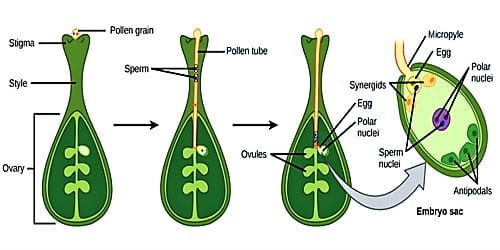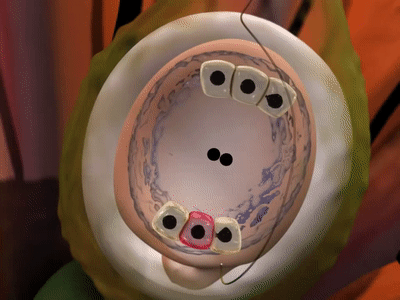Double Fertilization
Double fertilization is the unique and important biological process in flowering plants (Angiosperms) that allows for the formation of seeds and the continuation of the species.
Definition
Double Fertilization can be defined as the process in which two sperm cells are involved in the fertilization of a single ovule. It leads to the formation of a zygote, which will eventually develop into an embryo, and an endosperm, which is a tissue that will provide nutrients for the developing embryo.
Double Fertilization is the process in which both male gametes are utilized,one male gamete fuse with egg to form diploid zygote and another male gamete fuse with diploid secondary nucleus to form triploid primary endosperm nucleus is called Double Fertilization.
Double Fertilization in Flowering Plants (Angiosperms)
- The process of double fertilization starts when a pollinated flower’s ovary is fertilized by the sperm cell.
- Once the sperm cell reaches the ovule, it penetrates the outer layers and reaches the female gametophyte. The female gametophyte is a tissue within the ovule that contains two cells, the egg cell, and the central cell.
- Once the sperm cell reaches the female gametophyte, it fertilizes the egg cell which results in the formation of the zygote.
- The zygote is the first cell of the developing embryo. At the same time, the second sperm cell fertilizes the central cell, leading to the formation of the endosperm.
- The endosperm will provide the developing embryo with essential nutrients throughout its growth
Double fertilization occurs only in Angiosperms
Also Check – What is Fertilization ?
Who Discovered Double Fertilization?
Double fertilization was discovered by Nawaschin and Guignard.
Describe the Process of Double Fertilization in Details
Double Fertilization results in the formation of both the zygote and the endosperm, which play crucial roles in the development of the seed and the next generation of the plant.
In this process two sperm nuclei from the pollen grain fuse with two cells within the female reproductive organ, the ovule. This process leads to the formation of two distinct cells, the zygote and the primary endosperm nucleus (PEN).
Without double fertilization, flowering plants would not be able to produce seeds and their populations would decline over time.

Step by Step Process of Double Fertilization
6 steps of double fertilizations are –
- Pollination
- Germination of pollen
- Penetration of the pollen tube
- Release of two sperm cells
- Formation of zygote
- Formation of endosperm
Explanation of each steps of double fertilization process is as follows –
Pollination
- The first step of double fertilization is Pollination. Pollination is the transfer of pollen from the male reproductive organ (anther) of a flower to the female reproductive organ (stigma) of the same or another flower.
- Pollination is crucial for the fertilization of the female gamete, which will later develop into a seed.
- In the process of pollination the pollen grain adheres to the stigma, the sticky part of the pistil, which serves as the female reproductive organ.
- The pollen grain then germinates and releases a pollen tube that grows down the style and reaches the ovary, where the female gamete (ovule) is located.
- This contact between the pollen grain and the female gamete marks the beginning of double fertilization.
Also Check – “Pollination is Prerequisite for Fertilization in Flowering Plants” Explain
Germination of pollen
- Germination of pollen is an important step in the process of double fertilization in flowering plants. Germination of pollen occurs when a pollen grain reaches the stigma of the female reproductive organ (pistil) and begins to grow a pollen tube towards the ovary.
- Pollen grain contains two sperm nuclei. The germination of the pollen initiates the growth of a pollen tube that will carry the sperm nuclei to the ovules. The pollen grain absorbs moisture from the stigma, which causes the wall of the grain to soften and the germ cell inside to start dividing. As the germ cell divides, a pollen tube begins to grow out of the grain and moves towards the ovary.
- The pollen tube is guided by chemical signals from the stigma and the ovules and travels through the style of the pistil until it reaches the ovules.
Penetration of the Pollen Tube
- Penetration of the pollen tube is a significant step in the process of double fertilization in flowering plants. It occurs when the pollen tube, which carries the sperm nuclei, reaches the ovules in the female reproductive organ (ovary).
- As the pollen tube approaches the ovules it is guided by the chemical signals from the stigma and the ovules.
- The tip of the pollen tube then pierces the ovule wall,which allows the delivery of one of the sperm nuclei to the egg cell located inside the ovule.
- This penetration of the pollen tube into the ovule is an essential step in the fertilization process, as it enables the transfer of the sperm nucleus to the egg cell.
Release of two sperm cells
- The release of two sperm cells is a crucial step in the process of double fertilization in flowering plants. It occurs when the pollen grain germinates and begins to grow a pollen tube towards the ovary.
- The pollen grain contains two sperm nuclei, and as the germ cell inside the grain starts dividing, a pollen tube begins to grow out of the grain.
- The pollen tube carries the two sperm nuclei towards the ovules, where they will be delivered to the egg cell and the secondary nucleus, respectively.
- Once the pollen tube reaches the ovules, it pierces the ovule wall and delivers one of the sperm nuclei to the egg cell inside, resulting in the formation of a zygote. The other sperm nucleus will later fertilize the secondary nucleus in the ovule to form the endosperm.
Also Check – Why is Double Fertilization in Gymnosperms absent ?
Formation of zygote
- The “Formation of zygote” step in double fertilization is an important step in the sexual reproduction of flowering plants.
- During this step, one of the sperm cells that was released from the pollen grain into the female gametophyte fertilizes the egg cell.
- The first sperm nucleus fuses with the egg cell in the ovule to form a diploid zygote.
- The zygote is responsible for forming the embryo of the seed. The zygote contains all the genetic material necessary to form the new plant and will grow into a mature plant.
- Zygote initiates the process of embryonic development and will divide and differentiate into all of the tissues and organs that make up a mature plant.
Formation of endosperm
- The “Formation of endosperm” step in double fertilization is an important step in the sexual reproduction of flowering plants.During this step, Fertilization of the secondary nucleus takes place . the other sperm cell that was released from the pollen grain into the female gametophyte fertilizes the secondary nucleus (also known as the polar nuclei), resulting in the formation of the endosperm.
- The fertilization results in the fusion of the nuclei of the sperm and central cells, forming the primary endosperm cell.
- The primary endosperm cell undergoes several rounds of cell division, resulting in the formation of the endosperm tissue. Endosperm is a nutrient-rich tissue that provides essential nutrients to the developing embryo during seed germination and growth.
- Formation of the endosperm is an important step in double fertilization, as it sets in motion the creation of a tissue that is essential for the survival and growth of the developing plant.
Formation of seed
- The “Formation of seed” step in double fertilization is the final outcome of the sexual reproduction process in flowering plants. This step occurs after the “Formation of zygote” and “Formation of endosperm” steps, where the zygote and endosperm tissue have matured into a mature seed.
- In the “Formation of seed” step, the zygote undergoes several rounds of cell division and differentiation, resulting in the formation of the embryonic plant and the surrounding tissues that make up the seed. The endosperm tissue continues to mature and provide essential nutrients to the developing embryonic plant.
- The mature seed is a complex structure that contains the embryonic plant, the endosperm tissue, and a protective seed coat. The seed is designed to be dispersed by wind, water, or animals and has the potential to develop into a new plant once conditions are favorable.
6 Important Significance of Double Fertilization
- Formation of zygote- Zygotes forms in the process of double fertilization. Zygote is the first cell of the developing embryo. It contains the genetic material from both the male and female gametes and is responsible for the growth and development of the plant embryo.
- Nutrient supply to the developing embryo: Endosperm which is the product of double fertilization forms from the fusion of the second sperm nucleus and the second female gamete. It provides nutrients to the developing embryo. Endosperm is the source of energy and nutrients for the developing embryo and helps the plant to grow and develop properly.
- Reproductive Success – Double fertilization increases the reproductive success of flowering plants (Angiosperms ). It ensures that the fertilization process is efficient and effective, which leads to a high success rate of seed production.
- Evolutionary Advantages – Double fertilization has given flowering plants(Angiosperm) a significant advantage over other plant groups. Double fertilization has allowed them to evolve into a dominant group of plants in many ecosystems, as they have a higher success rate of seed production compared to other plant groups.
- Genetic Diversity- Double fertilization contributes to genetic diversity by allowing for the exchange of genetic material between male and female gametes. This leads to a higher likelihood of producing offspring with unique and varied traits, which can help the species to adapt and evolve to changing environmental conditions.
- Seed dispersal- Endosperm which is the product of double fertilization serves as a protective layer for the embryo and helps to disperse the seeds to new locations . It increases the chances of survival and establishment of the new plant.
Also Check – 9 Important Differences between Pollination and Fertilization
Also Check – 16 Important Differences between Cross Pollination and Self Pollination


4 Comments on “What is Double Fertilization ?”